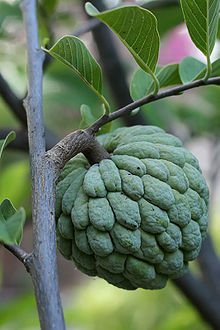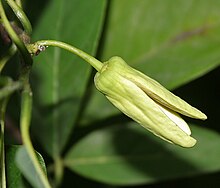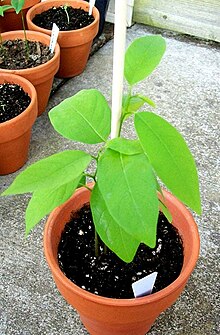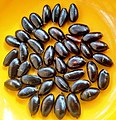Annona squamosa
| Annona squamosa | |
|---|---|

| |

| |
| Cross section of the fruit shown on right | |
| Scientific classification | |
| Kingdom: | Plantae |
| Clade: | Tracheophytes |
| Clade: | Angiosperms |
| Clade: | Magnoliids |
| Order: | Magnoliales |
| Family: | Annonaceae |
| Genus: | Annona |
| Species: | A. squamosa
|
| Binomial name | |
| Annona squamosa | |
| Synonyms | |
|
Annona asiaticaL.[3] | |
Annona squamosais a small, well-branched tree orshrub[7]from the familyAnnonaceaethat bears edible fruits calledsugar applesorsweetsops.[8]It tolerates a tropical lowland climate better than its relativesAnnona reticulataandAnnona cherimola[6](whose fruits often share the same name)[3]helping make it the most widely cultivated of these species.[9] Annona squamosais a small, semi-(or late)deciduous,[10] much-branched shrub or small tree 3 to 8 metres (10 to 26 feet) tall[7][10] similar tosoursop(Annona muricata).[11]It is a native oftropical climatein theAmericasandWest Indies,andSpanishtraders aboard theManila galleonsdocking in thePhilippinesbrought it to Asia.[12]In India, it is calledsitafal[13],and in Malaysia it is calledbuah nona.[citation needed]

Thefruitis spherical-conical, 5–10 centimetres (2–4 inches) in diameter and6–10 cm (2+1⁄4–4 in) long, and weighing 100–240 grams (3.5–8.5 ounces), with a thick rind composed of knobby segments. The colour is typically pale green through blue-green, with a deep pink blush in certain varieties, and typically has abloom.It is unique amongAnnonafruits in being segmented; the segments tend to separate when ripe, exposing the innards.
The flesh is fragrant and sweet, creamy white through light yellow, and resembles and tastes likecustard.The seeds are coated with the flesh, It is found adhering to13-to-16-millimetre-long (1⁄2to5⁄8in) seeds forming individual segments arranged in a single layer around a conical core. It is soft, slightly grainy, and slippery. The hard, shiny seeds may number 20–40 or more per fruit and have a brown to black coat, although varieties exist that are almost seedless.[12][14]The seeds can be ground for use as aninsecticide.[8]The stems run through the centre of the fruit connecting it to the outside. The skin is shaped like aReuleaux trianglecoloured green and rough in texture. Due to the soft flesh and structure of the sugar apple it is very fragile to pressure when ripe.
New varieties are also being developed inTaiwanand Hong Kong. Theatemoyaor "pineapple sugar-apple", a hybrid between the sugar-apple and thecherimoya,is popular in Taiwan, although it was first developed in theUnited Statesin 1908. The fruit is similar in sweetness to the sugar-apple, but has a very different taste. As its name suggests, it tastes like pineapple.
Description
[edit]


The fruit ofA. squamosa(sugar-apple) has sweet whitish pulp, and is popular intropicalmarkets.[10]In bengal it is called Ata phal.
Stems and leaves
[edit]
Branches with light brown bark and visible leaf scars; inner bark light yellow and slightly bitter; twigs become brown with light brown dots (lenticels – small, oval, rounded spots upon the stem or branch of a plant, from which the underlying tissues may protrude or roots may issue).[6]
Thin, simple, alternateleaves[11]occur singly,[6]5 to 17 centimetres (2 to6+3⁄4inches) long and2 to 6 cm (3⁄4to2+3⁄8in) wide;[10][6]rounded at the base and pointed at the tip (oblong-lanceolate).[10]They are pale green on both surfaces and mostly hairless[6]with slight hairs on the underside when young.[7]The sides sometimes are slightly unequal and the leaf edges are without teeth, inconspicuously hairy when young.[6][11]
The leaf stalks are0.4 to 2.2 cm (1⁄8to7⁄8in) long,[10]green, and sparsely pubescent.[6]
Flowers
[edit]Solitary or in short lateral clusters of 2–4 about 2.5 cm (1 in) long,[10]greenish-yellow flowers on a hairy, slender[6]2 cm (3⁄4in) long stalk.[10]Three green outer petals, purplish at the base, oblong,1.6 to 2.5 cm (5⁄8to 1 in) long, and0.6 to 0.75 cm (1⁄4to5⁄16in) wide, three inner petals reduced to minute scales or absent.[7][10]Very numerous stamens; crowded, white, less than1.6 cm (5⁄8in) long; ovary light green. Styles white, crowded on the raised axis. Each pistil forms a separate tubercle (small rounded wartlike protuberance), mostly1.3 to 1.9 cm (1⁄2to3⁄4in) long and0.6 to 1.3 cm (1⁄4to1⁄2in) wide which matures into the aggregate fruit.[6]
Flowering occurs in spring-early summer[10]and flowers are pollinated bynitidulidbeetles.[15]Its pollen is shed as permanent tetrads.[16]
Fruits and reproduction
[edit]Fruits ripen 3 to 4 months after flowering.[17]
Aggregate and soft fruits form from the numerous and loosely united pistils of a flower[6]which become enlarged[10]and mature into fruits which are distinct from fruits of other species ofgenus[6](and more like a giantraspberryinstead).
The round or heart-shaped[6]greenish yellow, ripened aggregate fruit is pendulous[10]on a thickened stalk;5 to 10 cm (2 to3+7⁄8in)[6][7]in diameter[10][11]with many round protuberances[6]and covered with a powdery bloom. Fruits are formed of loosely cohering or almost free carpels (the ripened pistels).[7]
The pulp is white tinged yellow,[7]edible and sweetly aromatic. Each carpel containing an oblong, shiny and smooth,[6]dark brown[7]to black,1.3 to 1.6 cm (1⁄2to5⁄8in) long seed.[6]
Nutrition and uses
[edit]| Nutritional value per 100 g (3.5 oz) | |||||||||||||||||||||||||||||||||||||||||||
|---|---|---|---|---|---|---|---|---|---|---|---|---|---|---|---|---|---|---|---|---|---|---|---|---|---|---|---|---|---|---|---|---|---|---|---|---|---|---|---|---|---|---|---|
| Energy | 393 kJ (94 kcal) | ||||||||||||||||||||||||||||||||||||||||||
23.64 g | |||||||||||||||||||||||||||||||||||||||||||
| Dietary fiber | 4.4 g | ||||||||||||||||||||||||||||||||||||||||||
0.29 g | |||||||||||||||||||||||||||||||||||||||||||
2.06 g | |||||||||||||||||||||||||||||||||||||||||||
| |||||||||||||||||||||||||||||||||||||||||||
| †Percentages estimated usingUS recommendationsfor adults,[18]except for potassium, which is estimated based on expert recommendation fromthe National Academies.[19] | |||||||||||||||||||||||||||||||||||||||||||
Sugar-apple is high inenergy,an excellent source ofvitamin Cand manganese, a good source of thiamine and vitamin B6,and provides vitamin B2,B3B5,B9,iron, magnesium, phosphorus and potassium in fair quantities.[20]
Chemistry
[edit]Thediterpenoidalkaloidatisineis the most abundant alkaloid in the root. Other constituents ofAnnona squamosainclude the alkaloidsoxophoebine,[21]reticuline,[21]isocorydine,[22]andmethylcorydaldine,[22]and theflavonoidquercetin-3-O-glucoside.[23]
Bayer AGhas patented the extraction process and molecular identity of the annonaceousacetogeninannonin,as well as its use as abiopesticide.[24]Other acetogenins have been isolated from the seeds,[25]bark,[26]and leaves.[citation needed]
Distribution and habitat
[edit]Annona squamosais native to the tropical Americas and West Indies, but the exact origin is unknown. It is now the most widely cultivated of all the species ofAnnona,being grown for its fruit throughout the tropics and warmer subtropics, such asIndia,Indonesia,Thailand,Taiwan,andChinaas far north asSuzhou;[27]it was introduced to southernAsiabefore 1590. It isnaturalizedas far north as southernFloridain theUnited Statesand as far south asBahiainBrazil,and is aninvasive speciesin some areas.[6][9][11]
- Native
- Neotropic
- Caribbean:AntiguaandBarbuda,Bahamas,Barbados,Cuba,Dominica,Dominican Republic,Grenada,Guadeloupe,Haiti,Jamaica,Martinique,Montserrat,Netherlands Antilles,Puerto Rico,St Kitts and Nevis,St Lucia,St Vincent and the Grenadines,Suriname,Trinidad and Tobago,Virgin Islands.
- Central America:Costa Rica,El Salvador,Guatemala,Honduras,Nicaragua,Panama
- Northern South America:Suriname,French Guiana,Guyana,Venezuela
- Western South America:Bolivia,Colombia,Ecuador,Peru
- Southern South America:Argentina,Brazil,Chile,Paraguay,Uruguay[6]
- Naturalised
-
- Pacific:Samoa,Tonga
- North America:Mexico,Belize
- Afrotropic:Angola, Namibia,Sudan,Tanzania,Uganda,Zanzibar,Kenya
- Australasia:Australia,Fiji,New Zealand,Papua New Guinea,Solomon Islands
- Indomalaya:Bangladesh,Cambodia,China,India,Indonesia,Laos,Malaysia,Nepal,Pakistan,Philippines,Sri Lanka,Taiwan,Thailand,Myanmar,Vietnam
- Palearctic:Cyprus,Greece,Lebanon,Malta,[6]Israel
Climate and cultivation
[edit]This sectionneeds additional citations forverification.(February 2021) |
Like most species ofAnnona,it requires a tropical or subtropical climate with summer temperatures from 25 °C (77 °F) to 41 °C (106 °F), and mean winter temperatures above 15 °C (59 °F). It is sensitive to cold and frost, being defoliated below 10 °C (50 °F) and killed by temperatures of a couple of degrees below freezing. It is only moderatelydrought-tolerant,requiring at least 700 millimetres (28 in) of annual rainfall, and does not produce fruit well during droughts.
It will grow from sea level to an altitude of 2,000 metres (6,600 feet) and thrives in hot dry climates, differing in its tolerance of lowland tropics from many of the other fruit bearers in theAnnonafamily.
It is quite a prolific bearer, and it produces fruit within as little as two to three years. A five-year-old tree can produce as many as 50 sugar apples. Poor fruit production has been reported in Florida because there are few natural pollinators (honeybees have a difficult time penetrating the tightly closed female flowers); however, hand pollination with a natural fibre brush is effective in increasing yield. Natural pollinators include beetles (coleoptera) of the familiesNitidulidae,Staphylinidae,Chrysomelidae,CurculionidaeandScarabaeidae.[9][14]
Ecology
[edit]In thePhilippines,the fruit is commonly eaten by the Philippinefruit bat(kabagorkabog), which then spreads the seeds from island to island.
It is a host plant for larvae of the butterflyGraphium agamemnon(tailed jay).
Uses
[edit]In traditional Indian, Thai, and Native American medicines, the leaves are boiled down with water, possibly mixed with other specific botanicals, and used in adecoctionto treatdysenteryandurinary tract infection.[28]Intraditional Indian medicine,the leaves are also crushed for use as a poultice, and applied to wounds.[28]In Mexico, the leaves are rubbed on floors and put in hens' nests, to repel lice.[9] InHaiti,the fruit is known ascachimanand is used to simply make juice.[29] In Lebanon and Syria, it is made into a variety of desserts and sweets, referred to asashta.[citation needed]
Gallery
[edit]-
Annona squamosa fruit from Myanmar
-
Sugar apple (right), with Taiwanese "pineappleshijia"(atemoya) (left)
-
The sugar apple readily breaks open when ripe.
-
A deconstruction of a sugar apple shows a lobe of fruit and pulpy segments with seeds.
-
A sugar apple ready to eat
-
Sugar apple (Annona squamosa) seeds
-
Red sugar apples fromMyanmar
-
Sugar apples inTaitung,Taiwan
-
Sugar apple tree inPhilippines
-
Two sugar apples inBangladesh
-
A sugar apple in tree in Terai ofNepal
References
[edit]- ^Botanic Gardens Conservation International (BGCI); IUCN SSC Global Tree Specialist Group (2019)."Annona squamosa".IUCN Red List of Threatened Species.2019:e.T146787183A146787185.doi:10.2305/IUCN.UK.2019-2.RLTS.T146787183A146787185.en.Retrieved16 December2022.
- ^Natural Resources Conservation Service (NRCS)."PLANTS Profile,Annona squamosaL ".The PLANTS Database.United States Department of Agriculture.Retrieved2008-04-17.
- ^ab"Annona squamosa".Germplasm Resources Information Network.Agricultural Research Service,United States Department of Agriculture.Retrieved2008-04-17.
- ^Dr. Richard Wunderlin, Dr. Bruce Hansen."synonyms ofAnnona squamosa".Atlas of Florida Vascular Plants.Institute for Systematic Botany, University of Florida.Retrieved2008-04-17.
- ^Missouri Botanical Garden(1753)."Annona squamosaL ".Tropicos.Retrieved2008-04-17.
- ^abcdefghijklmnopqrst"Current name:Annona squamosa".AgroForestryTree Database.International Center For Research In Agroforestry. Archived fromthe originalon 2011-05-26.Retrieved2008-04-17.
- ^abcdefgh"Compilation: Annona squamosa".Global Plants.JSTOR.Retrieved2019-09-05.
- ^abThe Complete Guide to Edible Wild Plants.United States Department of the Army.New York:Skyhorse Publishing.2009. p. 100.ISBN978-1-60239-692-0.OCLC277203364.
{{cite book}}:CS1 maint: others (link) - ^abcdMorton, Julia(1987)."Sugar AppleAnnona squamosa".Fruits of warm climates.Department of Horticulture & Landscape Architecture, Purdue University. p. 69.Archivedfrom the original on 5 April 2008.Retrieved2008-04-17.
- ^abcdefghijklmKral, Robert."Annona squamosaLinnaeus, Sp. Pl. 1: 537. 1753 ".In Flora of North America Editorial Committee (ed.).Flora of North America North of Mexico.Vol. 3.Retrieved2019-09-05.
- ^abcde"Annona squamosa".Pacific Island Ecosystems at Risk(PIER).2008-01-05.Archivedfrom the original on 12 May 2008.Retrieved2008-04-17.
- ^abMorton, Julia(1987)."Annona squamosa".Fruits of warm climates.p. 69.Retrieved6 March2013.
- ^Flora, Exotic."Custard Apple Balanagar (Grafted) - Fruit Plants & Tree".Exotic Flora.Retrieved2024-09-01.
- ^ab"Annona squamosa".AgroForestryTree Database.Archived fromthe originalon 14 March 2007.Retrieved16 September2013.
- ^McGregor, S.E.Insect Pollination Of Cultivated Crop PlantsArchived2023-03-26 at theWayback MachineUSDA,1976
- ^Walker JW (1971) Pollen Morphology, Phytogeography, and Phylogeny of the Annonaceae. Contributions from the Gray Herbarium of Harvard University, 202: 1-130.
- ^Grant, Amy (2021)."What Is Sugar Apple Fruit: Can You Grow Sugar Apples".Gardening Know How.Retrieved4 August2023.
- ^United States Food and Drug Administration(2024)."Daily Value on the Nutrition and Supplement Facts Labels".FDA.Archivedfrom the original on 2024-03-27.Retrieved2024-03-28.
- ^National Academies of Sciences, Engineering, and Medicine; Health and Medicine Division; Food and Nutrition Board; Committee to Review the Dietary Reference Intakes for Sodium and Potassium (2019). Oria, Maria; Harrison, Meghan; Stallings, Virginia A. (eds.).Dietary Reference Intakes for Sodium and Potassium.The National Academies Collection: Reports funded by National Institutes of Health. Washington, DC: National Academies Press (US).ISBN978-0-309-48834-1.PMID30844154.Archivedfrom the original on 2024-05-09.Retrieved2024-06-21.
- ^"Benefits of Custard apple".22 December 2014.
- ^abDholvitayakhun A, Trachoo N; et al. (2013)."Potential applications forAnnona squamosaleaf extract in the treatment and prevention of foodborne bacterial disease ".Natural Product Communications.8(3): 385–388.doi:10.1177/1934578X1300800327.PMID23678817.
- ^abYadav DK, Singh N; et al. (2011). "Anti-ulcer constituents ofAnnona squamosatwigs ".Fitoterapia.82(4): 666–675.doi:10.1016/j.fitote.2011.02.005.PMID21342663.
- ^Panda S, Kar A (2007). "Antidiabetic and antioxidative effects ofAnnona squamosaleaves are possibly mediated through quercetin-3-O-glucoside ".BioFactors.31(3–4): 201–210.doi:10.1002/biof.5520310307.PMID18997283.S2CID38336427.
- ^Moeschler HF, Pfluger W; et al. (August 1987)."Insecticide US 4689232 A".Retrieved2014-12-03.
- ^Chen Y, Xu SS; et al. (2012). "Anti-tumor activity ofAnnona squamosaseeds extract containing annonaceous acetogenin compounds ".Journal of Ethnopharmacology.142(2): 462–466.doi:10.1016/j.jep.2012.05.019.PMID22609808.
- ^Li XH, Hui YH; et al. (1990). "Bullatacin, bullatacinone, and squamone, a new bioactive acetogenin, from the bark ofAnnona squamosa".Journal of Natural Products.53(1): 81–86.doi:10.1021/np50067a010.PMID2348205.
- ^"Sweetsop (Annona squamosa)".January 2020.
- ^abDholvitayakhun A, Trachoo N; et al. (2016)."Using scanning and transmission electron microscopy to investigate the antibacterial mechanism of action of the medicinal plantAnnona squamosaLinn ".Journal of Herbal Medicine.7:31–36.doi:10.1016/j.hermed.2016.10.003.
- ^"Cachiman (Annona reticulata L.)".Carib Fruits.Retrieved8 November2020.
External links
[edit]![]() Data related toAnnona squamosaat Wikispecies
Data related toAnnona squamosaat Wikispecies
- "Annona squamosaL. "Integrated Taxonomic Information System.Retrieved17 March2008.
- David Lee."Photographs of treesAnnona squamosa".The Miami Tree Puzzle.Florida International University. Archived fromthe originalon 7 April 2008.Retrieved2008-04-17.
- Annona squamosa L.Medicinal Plant Images Database (School of Chinese Medicine, Hong Kong Baptist University)(in Chinese)(in English)













